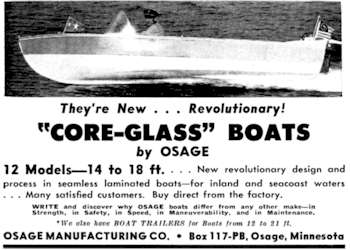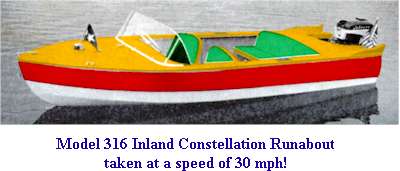By Lee Wangstad
The small town of Osage, located 11 miles due west of Park Rapids, Minnesota wasn’t new to me. I had read the name, been there, wondered if the town had ever been any larger than what it was when I first saw it. It didn’t consist of much more than a large lumber yard, a laundromat, and if I remember correctly, there was a canvas and awning shop, and not much else. We had stopped in town to buy bait. It seemed like such a long distance from Many Point Lake where my family goes for our annual fishing trip. If the fishing was particularly good, we would have to venture out of camp for bait, hitting all of the bait shops along the way, until we would find one with just the right bait. We knew that we eventually would make it to Osage because our outing was usually in early October, when most of the tackle shops were either closed or weren’t stocking much live bait. I think that at times, we would all pile into the car just to get out of camp for a ride down the crazy, winding back roads that never seemed to go anywhere, but somehow took you exactly where you wanted to go.
 What really made me come back to this place at all, now that the bait shop had closed its doors and had become just so much local history, was a small advertisement that I spotted in an early issue of Popular Boating. What caught my eye was an ad for “Core-Glass” boats, built right in Osage, by the Osage Manufacturing Company. This one had been new to me. What really held my interest was that here was a company, advertising on a national level, building fiberglass boats way up north back in the early fifties. To be advertising regularly must have meant that they were having some degree of success at it. I copied the ad and filed it away with those things that somehow grab my attention and won’t let go. Later, I would run across the same ad in Sports Afield, Outdoor Life, and even Popular Mechanics magazines from the same era. The more often that I saw the ad, the deeper it would ingrain itself into my mind.
What really made me come back to this place at all, now that the bait shop had closed its doors and had become just so much local history, was a small advertisement that I spotted in an early issue of Popular Boating. What caught my eye was an ad for “Core-Glass” boats, built right in Osage, by the Osage Manufacturing Company. This one had been new to me. What really held my interest was that here was a company, advertising on a national level, building fiberglass boats way up north back in the early fifties. To be advertising regularly must have meant that they were having some degree of success at it. I copied the ad and filed it away with those things that somehow grab my attention and won’t let go. Later, I would run across the same ad in Sports Afield, Outdoor Life, and even Popular Mechanics magazines from the same era. The more often that I saw the ad, the deeper it would ingrain itself into my mind.
One day while in Park Rapids on business, I happened to stop in on Dick & Nancy Rutherford who were busy unloading swap meet items from a large enclosed trailer. They had just returned from a big “back to the 50’s” car show and were busy trying to settle back in. Of course, I was looking for old boat stuff, and they were kind enough to let me look through their shop. I was going through some old Popular Mechanics magazines when I spotted that same ad for Core-Glass boats. When I asked them about the boat company located in Osage, they weren’t quite sure. Both had lived in Park Rapids all their lives and their grasp of the local history was fantastic, but boats obviously weren’t their thing. They were able to direct me to others in the community that could help. I was finally getting a start on a project that had been eight years in the making!
 My first call was to Bob Wallick in Park Rapids. Yes, he had built boats at his marine dealership in Park Rapids; they were called Pramco Boats. As it turned out, this was not the company that I was looking for, but I wrote down all the notes on this venture. It was another of those companies that never had a major impact on the industry, yet combined with everything that was going on at the time, was still a part of the market. With my interest in Minnesota boat builders, it was an intriguing story. As I went down my list of people that might have some information, I happened to call Hank Noble. Hank was able to put it all into focus for me.
My first call was to Bob Wallick in Park Rapids. Yes, he had built boats at his marine dealership in Park Rapids; they were called Pramco Boats. As it turned out, this was not the company that I was looking for, but I wrote down all the notes on this venture. It was another of those companies that never had a major impact on the industry, yet combined with everything that was going on at the time, was still a part of the market. With my interest in Minnesota boat builders, it was an intriguing story. As I went down my list of people that might have some information, I happened to call Hank Noble. Hank was able to put it all into focus for me.
Hank Noble’s family owned Osage Manufacturing Company. Before World War II they were the nation’s largest builder of wagon boxes. These were the wooden boxes attached to grain trailers used by farmers to get their harvest to market. After the war, trucks were becoming more commonplace and the orders for their wagon boxes were beginning to slow. They decided to get into the boat building business. Here is where I had gotten into trouble before while trying to research Core-Glass. There was another boat builder in Osage — Noeske Boat Works — which operated out of the Noeske Lumber Company. For many years I had thought that there must be some connection between the two and was looking in all the wrong places. As it turned out, the only connection was that they were both located in Osage! I had also thought that there was some connection with Core-Craft, which was located in Bemidji, but while the Noble’s knew about these other companies, there was no relationship between them.
The first boats built by Osage Manufacturing were cedar strip rowboats, built in much the same fashion as most of the other builders in the state. With the introduction of fiberglass in the early fifties, they investigated the use of that product. There was a company up in Bemidji that was building cedar strip boats covered with fiberglass called Core-Craft. We tried covering our cedar strip boats with fiberglass, but had trouble,” remembers Hank Noble. “The cedar has certain oils in it, and the polyester resins weren’t adhering to the wood in certain areas where the oils were coming out, causing the boats to delaminate. We switched to marine grade plywood covered with fiberglass mat.” The result was an extremely strong wood-core fiberglass boat.
“We used to advertise on television in the Fargo area,” says Noble. “We would take a section of one of our boats and place a brick on it and invite people to hit it with a hammer. The brick would break all to pieces but hardly put a scratch in the fiberglass.” They started out building fishing boats especially for the resort trade in the lake-rich part of the country where they were located. Soon they were building decks to convert the fishing boats into runabouts.
The Noble’s also decided that, just as they had with their wagon boxes, they would take their trade up to a national level and began advertising in magazines that would give them broader market coverage. One difference in their marketing approach was the decision to market direct from the factory.
“We sold boats all over the world direct from the plant in Osage,” reminisces Noble. “There were no distributors or dealers. We would build boats all winter and in the spring, all hell would break loose and we’d have to run around like crazy to try to sell, build, and stock all at the same time. Of course everyone just had to have their boats at once on the same day! We sold complete packages after a while,” says Noble. “You could order your boat complete with a motor and trailer. We sold Mercury outboards and Balko trailers in our packages. We started out with Scott-Atwater, but later switched to Mercury. It made it a lot easier to buy that way, completely rigged with all of the controls and hardware. At that time you couldn’t always buy a complete package.”
Their lineup consisted of 14, 16, and 18 foot runabouts and fishing boats. They had a no-nonsense styling theme and hulls designed more for performance than trendy lines.
 Their Inland Runabout line came in 14 & 16 foot lengths and the recommended horsepower ratings were up to 60 hp for the runabouts and wider fishing boats. The narrow fishing boats had a maximum rating of 15 hp.
Their Inland Runabout line came in 14 & 16 foot lengths and the recommended horsepower ratings were up to 60 hp for the runabouts and wider fishing boats. The narrow fishing boats had a maximum rating of 15 hp.
The Sea Coast line were 16 & 18 feet and surprisingly enough, had “no limit” listed in the recommended horsepower column in their literature. It also stated that the boats could be powered by either one or two motors. The 18 foot models had a broad 72 inch beam to make these boats really adaptable to big water. “I remember that we shipped a lot of the larger boats to both Leech Lake and Lake of the Woods,” says Hank Noble. There was also an Inland Constellation line of upscale runabouts featuring twin cockpits in both 14 & 16 foot lengths. They were built to accommodate up to 60 hp, just like Inland line and even sported small, stylish fins at the rear decks.
“We built boats until the early 60’s,” remembers Hank, “when one of the recessions finally did us in. It was such an up and down market. It just got too hard to hold on. When a recession hits, the first thing that people stop buying is the non-essential things like boats.”
“We went into the wood shavings business, for agricultural use,” says Hank, “we never went back to building boats. I still have the last boat that we made, a 14 foot fishing boat. You know, it still looks pretty good. It was really over built, as they all were.”
So ends another chapter in Minnesota’s impact on the national marine marketplace. It was companies like Osage Manufacturing that were marketing on a national scale that would fuel Americas unquenchable thirst for recreational products during the boating boom of the 50’s. It was families like Hank Noble’s that were able to read that market and see it coming and adjust to it that made it so fascinating. Just as they saw the need to get into the boating market, they also saw the need to leave it and adapt to other products. Hank Noble remembers the boating years fondly. “It was crazy all the time, but we really enjoyed the business!”

